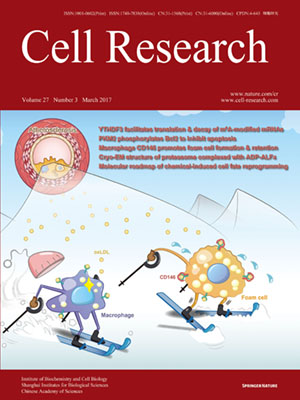
Volume 27, No 3, Mar 2017
ISSN: 1001-0602
EISSN: 1748-7838 2018
impact factor 17.848*
(Clarivate Analytics, 2019)
Volume 27 Issue 3, March 2017: 444-447
LETTERS TO THE EDITOR
Cytoplasmic m6A reader YTHDF3 promotes mRNA translation
Ang Li1,2,*, Yu-Sheng Chen1,2,*, Xiao-Li Ping1,2, Xin Yang1,2, Wen Xiao1,2, Ying Yang1,2, Hui-Ying Sun1,2, Qin Zhu1,2, Poonam Baidya1,2, Xing Wang1,2, Devi Prasad Bhattarai1,2, Yong-Liang Zhao3, Bao-Fa Sun1,3 and Yun-Gui Yang1,2
1Key Laboratory of Genomic and Precision Medicine, Collaborative Innovation Center of Genetics and Development, CAS Center for Excellence in Molecular Cell Science, Sino-Danish College, Beijing Institute of Genomics, Chinese Academy of Sciences, Beijing 100101, China
2College of Future Technology, University of Chinese Academy of Sciences, Beijing 100049, China
3Key Laboratory of Genomic and Precision Medicine, China Gastrointestinal Cancer Research Center, Sino-Danish College, Beijing Institute of Genomics, Chinese Academy of Sciences, Beijing 100101, China
Correspondence: Yun-Gui Yang, E-mail: ygyang@big.ac.cn; Bao-Fa Sun,(sunbf@big.ac.cn)
N6-methyladenosine (m6A), as the most abundant internal modification with ubiquitous feature in eukaryotic mRNAs, has been connected with many fundamental aspects of RNA metabolism such as translation1,2,3, splicing4,5, stability and decay6. m6A modification is reversible and can be regulated by three groups of molecules commonly referred to as writers, erasers and readers. m6A writers are the components of the multi-complex methyltransferase catalyzing the formation of m6A methylation, among which METTL3, METTL14,
10.1038/cr.2017.10
FULL TEXT | PDF
Browse 2304


